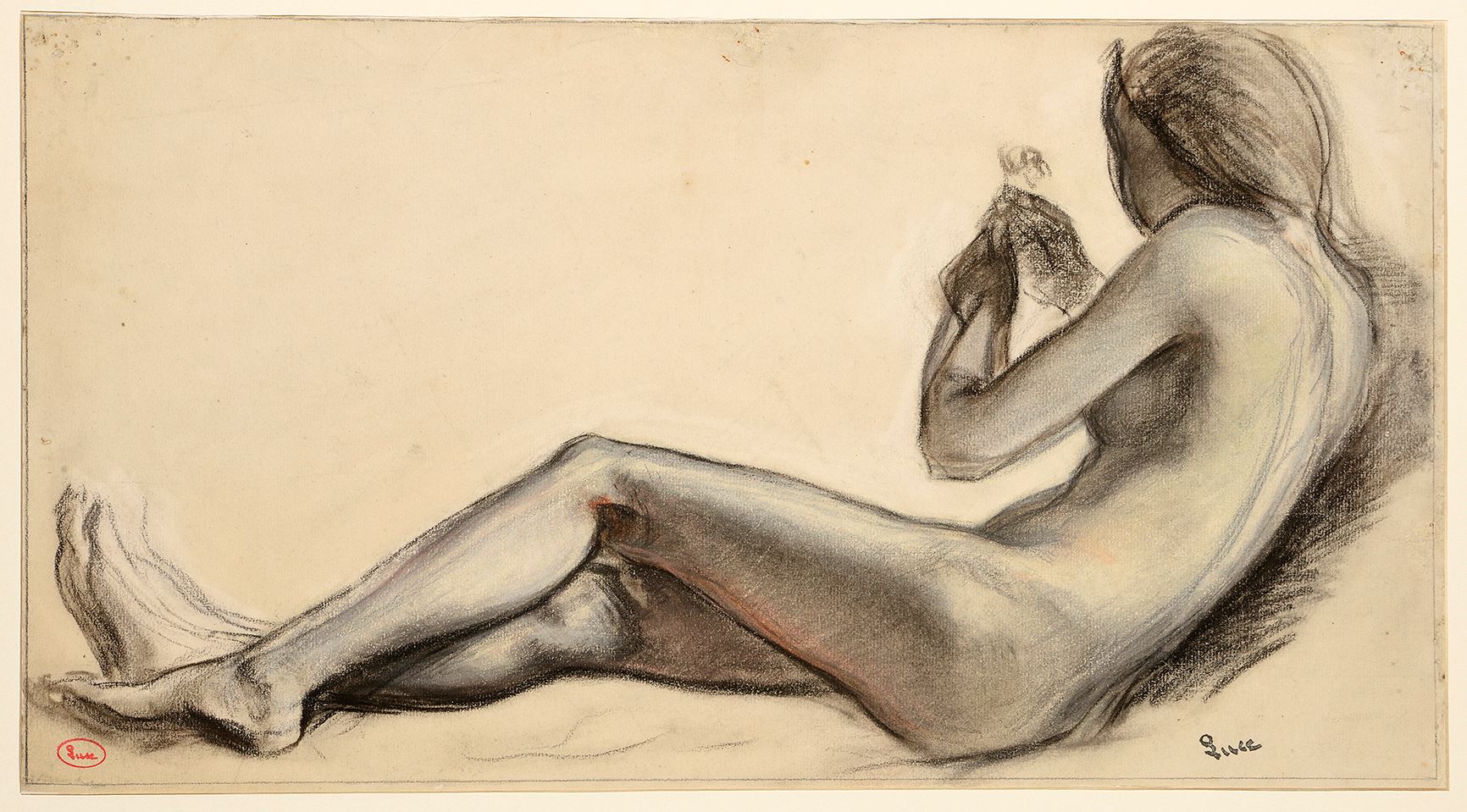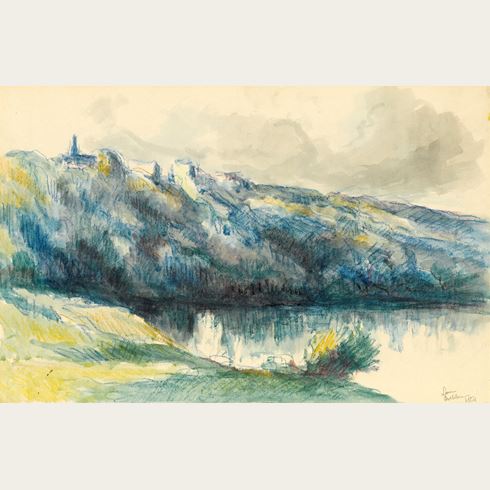Maximilien LUCE
(Paris 1858 - Paris 1941)
Study of a Nude Bather
Black chalk, pastel and pencil, with framing lines in pencil.
Stamped with the artist’s signature Luce (not in Lugt) in black ink at the lower right, and with the atelier stamp Luce in a circle (not in Lugt) in red ink at the lower left.
Stamped with a drystamp Maximilien Luce / J. Bouin-Luce (not in Lugt) at the lower right.
Further stamped COLLECTION/ JEAN-BOUIN LUCE (not in Lugt) in black ink and numbered CR 954 in pencil on the verso.
254 x 468 mm. (10 x 18 3/8 in.)
Stamped with the artist’s signature Luce (not in Lugt) in black ink at the lower right, and with the atelier stamp Luce in a circle (not in Lugt) in red ink at the lower left.
Stamped with a drystamp Maximilien Luce / J. Bouin-Luce (not in Lugt) at the lower right.
Further stamped COLLECTION/ JEAN-BOUIN LUCE (not in Lugt) in black ink and numbered CR 954 in pencil on the verso.
254 x 468 mm. (10 x 18 3/8 in.)
This splendid, large drawing is a study for a figure at the lower right of Luce’s large painting Bathers at Saint-Tropez, painted in 1892 during his first of several visits to Saint-Tropez, and today in a private collection. Two further studies by Luce for other female nudes in the same painting, each squared for transfer and much less refined in execution than the present sheet, are in private collections. A related, large oil sketch of the composition, with several differences in the arrangement of the figures, is also in a private collection.
As the contemporary scholar Adolphe Tabarant, writing in 1894, noted, ‘Luce tries to tell us about Saint-Tropez, Camaret and London in a score of paintings…How it all pulsates and how true it rings!’
As the contemporary scholar Adolphe Tabarant, writing in 1894, noted, ‘Luce tries to tell us about Saint-Tropez, Camaret and London in a score of paintings…How it all pulsates and how true it rings!’
Born in the Parisian neighbourhood of Montparnasse, Maximilien Luce displayed a lifelong interest in the depiction of the daily life of the working-class city folk he grew up with. Trained initially as a wood-engraver, he took up landscape painting in the late 1870’s. Although best known for his work as a Neo-Impressionist painter, Luce often preferred urban subjects to the landscape views produced by such colleagues as Camille Pissarro and Paul Signac. Like Signac and Henri-Edmond Cross, Luce continued to work in a Neo-Impressionist, or pointillist, manner for many years after the death of the group’s leader Georges Seurat, in 1891. He exhibited with the Neo-Impressionist artists at the Salon des Indépendants, and also took part in the exhibitions organized by Les XX in Brussels in 1889 and 1892. His strong left-wing political convictions and hostility towards the authoritarianism of the Second Empire also found expression in much of his art, and particularly in his graphic work, which included illustrations for several anarchist and subversive broadsheets, including Le Père Peinard, Le Chambard and Le Temps Nouveau.
A member of the French anarchist movement, Luce was briefly imprisoned as a political activist in 1894. From about 1895 onwards, and partly under the influence of Camille Pissarro, Luce began to move away from the Neo-Impressionist manner. He painted a number of urban views, in particular scenes of Notre-Dame, as well as depictions of men at work, rural landscapes and a handful of splendid portraits of fellow artists. Luce continued to exhibit his work regularly, with a series of one-man exhibitions at such Parisian galleries as Durand-Ruel, Druet and Bernheim-Jeune. His work was also shown in Germany, Belgium and Switzerland.
Provenance
In the artist’s studio at the time of his death
By descent in the family of the artist to Jean Bouin-Luce (with his collection drystamp, not in Lugt, at the lower right)
Anonymous sale, Paris, Hôtel Drouot, 23 May 2007, lot 94
Jean-Luc Baroni Ltd., London, in 2008
Private collection, London.
By descent in the family of the artist to Jean Bouin-Luce (with his collection drystamp, not in Lugt, at the lower right)
Anonymous sale, Paris, Hôtel Drouot, 23 May 2007, lot 94
Jean-Luc Baroni Ltd., London, in 2008
Private collection, London.
Literature
Jean Bouin-Luce and Denise Bazetoux, Maximilien Luce: catalogue raisonné de l’oeuvre peint, Paris, 1986, Vol.II, p.239, no.954.









